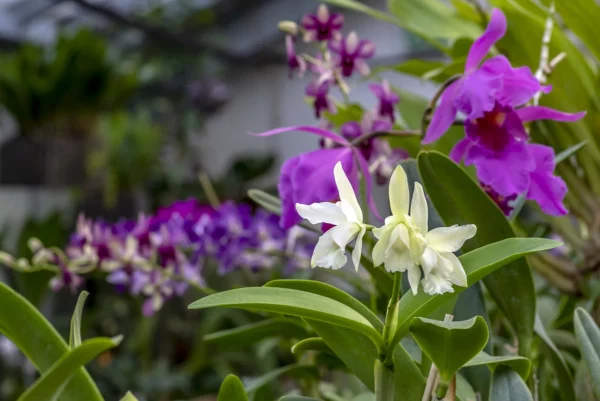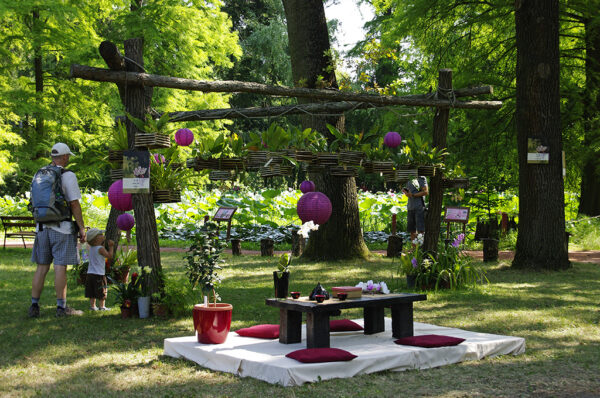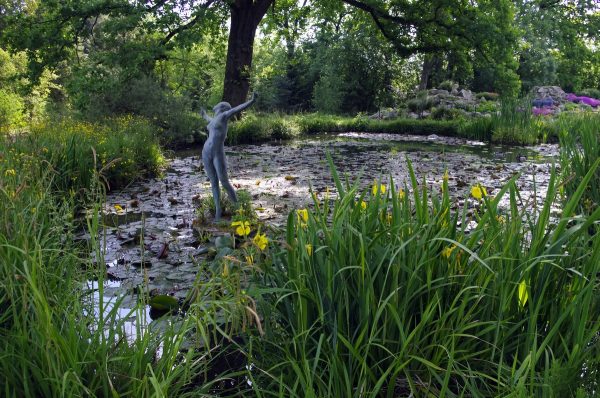14.30 We say goodbye to the lotuses
Our portal also gathers while the guests relax in the shade and listen to the meditation exercises taking place on stage. It is worth re-reading our reports and admiring our photos so that you can relive the peaceful atmosphere of the Lotus Days.
It is also worth choosing the Herb Garden tomorrow, as we can get answers to the secret of health and a happy life, get to know Eastern martial arts, Indian food and, of course, lotuses. See you next year!
14.10 They said the blissful yes among lotuses
Katalin Veselicz and Norbert Kőműves said their happy yes among the lotuses of the Botanical Garden. Their wedding will be held in the afternoon in the Erzsébet Church in Újszeged, but before that they also took some photos next to the beautiful, blooming plant - just like us. We wish the young couple much happiness!
13.45 Carnivorous plants for home
Pitcher, dionaea and dew grass. We can even get such "meat eaters" in our homes. Exotic plants need to stand in water, they like hot sunlight, and they don't even need a nutrient solution in the colder months. Hammer from Melinda, we learned from the florist of Marczika horticulture that more and more people are looking for tropical specialities, even after the opening there were interested people who took away a pot as a gift. He showed how the flycatcher, known as the Venus flytrap, reacts to human touch: if you stroke its mouth full of "teeth", it will fold its fleshy leaves. Melinda Kalapács warned that those who want to color their apartment with such a plant should rarely caress it, because it is offensive and will not open its mouth wide over time.
Horticulture is otherwise known for its orchid wonders, in addition to the beauties available in flower shops, blooming botanical and hybrid orchids are sold.
13.05 From sabji to semolina sweets - tips for Saturday lunch
At the base of the stage located next to the entrance, the food tasting combined with the informative presentation ended. From the Őrangyal Gastroház in Szeged, we learned what Krishna-conscious eating is like, and what is on Indian plates every day. Spicy - this is the one word that can best describe their kitchen, where they do not use meat or only keep it to a minimum.
One of their typical main dishes is the so-called sabji, which is nothing more than a vegetable stew made of potatoes, green beans, green peas, cauliflower and carrots. Two versions are known, one is boiled, the other is fried, but both recipes are always roasted on a basic broth turbocharged with Indian spices, in the chsatnik.
As a side dish, it is worth making rice sprinkled with hing and sprinkled with ground pepper. Hing is nothing but a kind of onion substitute, which is the basis of Krishna conscious eating. In India, for reasons of principle, neither garlic nor mushrooms are consumed. For all of this, it is worth choosing the semolina dessert toasted in butter. Valava is a pineapple dessert topped with simple sugar syrup.
12.30 Real democracy was realized in the tea garden
The creator of the Füvészkert's Japanese garden Zoltán Dani also visited our stand. The designer learned the craft in the capital of gardens, Kyoto Yoshimichi Hiraoka under his assistance, whose family has been developing Japanese gardens for three generations. If you have studied both the theory and practice of horticulture for a year, then you want to implement the experience gained abroad with your company based in Szentendre.
According to style and age, these gardens can be divided into several categories, which were developed separately after the Edo period, in the 17th century they together formed the modern Japanese gardens. The first to emerge were the paradise gardens, which were built by the emperors themselves in order to evoke the islands in the legends promising eternal life. Its characteristic is that it has a turtle and crane island, which can also be found in the herb garden. In the Zen gardens, one can search for inner peace within oneself, following Buddhist teachings. One can enter the path of Zen in several ways - one can find peace in anything that one does with love and devotion. The creation of these gardens is still in progress in the herb garden.
The Roji tea gardens were born during the Japanese Renaissance. "True democracy was born here, long before the French Revolution: whoever entered a tea garden put down his sword at the entrance, everyone was considered equal. The opponents sat down here in peace, facing each other, and dealt with the problems with new ideas," said Zoltán Dani.
In the meantime, our photographer didn't hesitate either, we can update our article with another gallery!
11.54 Animal inhabitants of the lake
We discovered special creatures in the pond of lotuses: turtles warmed their shells on the lotus leaves, frogs licked in the still, calm water. A few dragonflies also appeared, performing their nuptial dance on the blades of grass.
11.15 The statue didn't disappear, it just moved
Anikó Németh, director of the herb garden, said: the stretching female statue did not fit in the Japanese garden created by the lake, so it was relocated to the water lily pond. Until now, its place was occupied by turtles, and a turtle island was created for them at the lake. The stone lantern shown in the photo below took the place of the statue.
The Japanese garden is created with great care and on the basis of a strict system of rules, in which every single plant and ornament has symbolic significance. We will soon provide you with details about the herb garden's Japanese garden!
11.00 Hundreds of people in the herb garden
The program continued with yoga and a tai chi presentation, hundreds of families visited during the morning. Our photographer also took a walk, take a look at our gallery!
10.49 The lotus was revered in Egypt as well
The Lotus Days started in style with a lotus tour. Unfortunately, due to the rainy weather of the past weeks and months, we cannot admire the aquatic plants in their full splendor, even now many buds are striving towards the beneficial sunlight. Dancer Enikő, the Füvészkert staff member not only told the interested parties about the characteristics of the lotus rooted from the depths of the water, but also presented its everyday uses. We find it in perfumes, foods, and liqueurs, using all parts of the plant.
The diameter of the flower of the pink Indian cult plant rivals the size of a small pizza, its stem is rooted meters deep in the lake, burrowing into the soft soil in a special way. Its peak flowering is in July - this year it is expected to be postponed to August - but it still presents a colorful sight in the pond of the botanical garden in Szeged. The dried "seed house" that has lost its petals hides many fruits, the yellow fruiting body thickens over time, takes the shape of a shower rose, and spills out its seeds.
Not only in the Far East, but also in Egypt, the lotus is held in high esteem, or more precisely, a type of fairy rose that sounds similar to the lotus. The blue fairy rose is a symbol of the Sun God, it opens at dusk and is visible in all its glory at night. It is interesting that the Indian lotus also reached the country around the Nile, the last dynasties probably introduced it from Persia. The hallmarks of the lotus appear in works of art, religion and, to this day, in modern architecture.
10.10 Where did the stretching statue go?
During our walk around, we noticed that the figure of a woman stretching, which is the symbol of the Botanical Garden, had disappeared from its place. We will soon find out where he moved!
In the meantime, more and more people are arriving, the adjacent parking lot is already fully occupied, but visitors can only park their bicycles nearby. Fortunately, after last year's inhuman heat, the weather is really pleasant.
9.25 SZEGEDma.hu is already in the garden
We have set up our stand in the Botanical Garden, from where we provide interesting facts and photo reports all day long for all those who want to follow the Lotus Days from the cool of the room. Stay with us!
Japanese drum concert and Chinese dances
As in previous years, the inspiration for the two-day festival is from the Far East, one of the rare jewels of the botanical garden, the blossoming of the Indian lotus from the temperate region of Asia, the director of the Botanical Garden of the University of Szeged told MTI. Aniko Németh explained: the program is very diverse. On the stage, for example, martial arts performances, the exoticism of classical Indian dances and different types of yoga fill the green environment. Compared to previous years, they are preparing for even more interesting events, for example, on Saturday afternoon there will be a traditional Chinese Lion Dance presentation, and on Sunday there will be a traditional Japanese drum concert by the Taiko Hungary Drum Group. You can also get to know the Japanese garden that was handed over this year, which presents the Asian flora as the final stop of the lotus tour.
The performances take place on the open-air stage and in the cashier's building at the main entrance, in the latter a bonsai exhibition awaits visitors. On both days, countless opportunities are offered for family crafts, to try yoga exercises, and to taste delicious spicy oriental flavors. The sacred plant of Buddhists began to bloom in the southern plain park at the beginning of the month. The Indian lotus (Nelumbo nucifera), native to Southeast Asia, can be seen in the Szeged University Botanical Garden from mid-August to early September, depending on the weather. The Indian lotus is one of the pride of the facility, the largest open-air stock of the flower in Central Europe can be found here.
The first plants were introduced to the Szeged Botanical Garden in 1932. István Győrffy Director then found the lotus in a pond in the park of the Návay Castle on a plant-collecting road in Óföldeák. Among the members of the family was a plant collector who grew several specialties at home. The herb garden got some stems from this collection. The plants overgrew the entire lake in a few years, but by the 1980s, for some unknown reason, the population had died out. In 1982, after a thorough cleaning of the lake, the flower was replanted from its own seed, which now turns the small lake into a sea of flowers every summer.
Source: SzegedMa.hu










